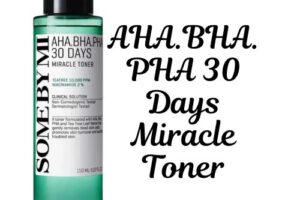Everything About AHAs and BHAs(+Retinol)
AHAs and BHAs are popular skincare ingredients that offer powerful exfoliating benefits, but they work in different ways, making each better suited for specific skin types and concerns.
AHAs (alpha-hydroxy acids) are water-soluble acids derived from fruits. They exfoliate the skin’s surface, helping to improve texture and tone. AHAs are especially good for normal to dry skin types as they focus on surface-level exfoliation, leaving the skin smoother and more radiant.
BHAs (beta-hydroxy acids), such as salicylic acid, are oil-soluble. This allows them to penetrate deeper into the pores, making them ideal for oily and acne-prone skin. BHAs work to unclog pores and help reduce breakouts by exfoliating within the skin.
Retinol, a form of vitamin A, boosts cell turnover, addressing acne, aging, and hyperpigmentation. It works well for most skin types but can sometimes cause dryness, so it’s important to balance it with hydrating products.
Choosing between these acids depends on your skin type and concerns. AHAs work best for surface exfoliation and improving texture, while BHAs are better for deep cleansing pores and reducing acne.
Benefits
AHAs:
- Exfoliate the surface of the skin, removing dead cells.
- Brighten the complexion and provide a more radiant look.
- Help reduce the appearance of fine lines.
- Improve the overall texture of the skin, making it smoother.
BHAs:
- Unclog pores by dissolving excess oil and dead skin inside.
- Reduce acne breakouts by targeting deeper layers of the skin.
- Calm inflammation and redness, especially beneficial for sensitive or acne-prone skin.
- Exfoliate deeper within the pores, making it ideal for oily skin types.
Retinol:
- Promotes collagen production, helping to firm and plump the skin.
- Improves skin elasticity, giving a more youthful appearance.
- Treats acne by increasing cell turnover and preventing clogged pores.
- Reduces the appearance of wrinkles and fine lines.
- Helps fade dark spots and hyperpigmentation over time.
Combining
Use AHAs or BHAs in the morning: These exfoliating acids work well during the day to brighten the skin or clear out pores, but they can make your skin more sensitive to sunlight. So, always follow with sunscreen.
Use retinol at night: Retinol can be drying and increases skin sensitivity to the sun, so nighttime use is ideal. This gives your skin time to repair while you sleep.
Sunscreen is a must: Since both exfoliants and retinol can make your skin more vulnerable to UV damage, applying a broad-spectrum sunscreen daily is essential to protect your skin and maintain the benefits of these treatments.
Best way to use each ingredients
| Category | AHAs (Alpha-Hydroxy Acids) | BHAs (Beta-Hydroxy Acids) | Retinol |
|---|---|---|---|
| Solubility | Water-soluble (work on the skin’s surface). | Oil-soluble (penetrates pores to clear oil and dirt). | Vitamin A derivative, works deep within the skin. |
| Ideal For | Normal, dry, or mature skin types. | Oily, acne-prone, or sensitive skin types. | Suitable for all skin types, especially acne-prone or aging skin. |
| When to Use | Best used in the morning for exfoliation. | Can also be used in the morning but suitable for regular exfoliation of oily skin. | Best used at night as it breaks down in sunlight and increases UV sensitivity. |
| Key Benefits | Brightens complexion, reduces fine lines, and evens skin tone. | Reduces acne, calms inflammation, and deeply exfoliates pores. | Promotes collagen, treats acne, reduces wrinkles, and fades dark spots. |
| Side Effects | May cause sensitivity, dryness, or irritation, especially on sensitive skin. | Can cause slight dryness or irritation but is generally milder for acne-prone skin. | May cause dryness, flaking, especially during initial use. |
| Sun Sensitivity | Increases sun sensitivity, sunscreen is essential. | Increases sun sensitivity, sunscreen is essential. | Increases sun sensitivity, sunscreen is essential. |
Chemical Peeling Advantages And Disadvantages
How To Treat Dark Spots On Face
How To Get Rid Of Acne Scars Fast
[Retinol] How to use, side effect
Retinol Vs Hyaluronic Acid For Wrinkles
Tips for AHAs, BHAs, and Retinol
When incorporating AHAs, BHAs, and retinol into your skincare routine, timing and application methods can greatly influence their effectiveness and minimize potential irritation. Here are some practical tips:
- Alternating Nights: If you’re using AHAs or BHAs along with retinol, consider alternating their application on different nights. This approach allows your skin to benefit from each ingredient without overwhelming it, reducing the risk of irritation.
- Sequential Application: If you prefer to use AHAs or BHAs and retinol on the same night, apply them sequentially with a 30-minute gap in between. Start with your AHA or BHA product first, allowing it to penetrate and work on your skin for about 30 minutes. After this period, apply your retinol product. This method helps each ingredient work effectively while minimizing the chances of irritation.
- Listen to Your Skin: Pay attention to how your skin reacts. If you experience any excessive dryness or irritation, consider reducing the frequency of use or adjusting the timing of your applications.
- Follow Up with Moisturizer: Always follow up with a hydrating moisturizer after applying these active ingredients. This step helps maintain your skin’s moisture balance and soothes any potential irritation.
- Daily Sunscreen: Finally, regardless of your routine, applying sunscreen daily is crucial, especially when using AHAs, BHAs, and retinol. These ingredients can increase your skin’s sensitivity to the sun, making it more susceptible to damage.














Post Comment